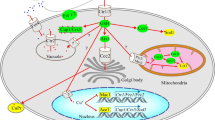Abstract.
The topological arrangements of nitrate and nitrite reductases in bacteria necessitate the synthesis of transporter proteins that carry the nitrogen oxyanions across the cytoplasmic membrane. For assimilation of nitrate (and nitrite) there are two types of uptake system known: ABC transporters that are driven by ATP hydrolysis, and secondary transporters reliant on a proton motive force. Proteins homologous to the latter type of transporter are also involved in nitrate and nitrite transport in dissimilatory processes such as denitrification. These proteins belong to the NarK family, which is a branch of the Major Facilitator Superfamily. The mechanism and substrate specificity of transport via these proteins is unknown, but is discussed in the light of sequence analysis of members of the NarK family. A hypothesis for nitrate and nitrite transport is proposed based on the finding that there are two distinct types of NarK.
Similar content being viewed by others
Author information
Authors and Affiliations
Rights and permissions
About this article
Cite this article
Moir*, J., Wood, N. Nitrate and nitrite transport in bacteria . CMLS, Cell. Mol. Life Sci. 58, 215–224 (2001). https://doi.org/10.1007/PL00000849
Issue Date:
DOI: https://doi.org/10.1007/PL00000849




